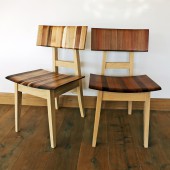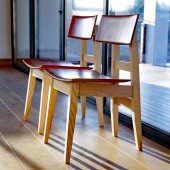
| THE AWARD |
| CATEGORIES |
| REGISTRATION |
| SUBMIT YOUR WORK |
| ENTRY INSTRUCTIONS |
| TERMS & CONDITIONS |
| PUBLICATIONS |
| DATES & FEES |
| METHODOLOGY |
| CONTACT |
| WINNERS |
| PRESS ROOM |
| GET INVOLVED |
| DESIGN PRIZE |
| DESIGN STORE |
| THE AWARD | JURY | CATEGORIES | REGISTRATION | PRESS | WINNERS | PUBLICATIONS | ENTRY INSTRUCTIONS |
Zene Dining Chair by John G Williams |
Home > Winners > Design #58495 >Interview |
 |
|
FS: What is the main principle, idea and inspiration behind your design?
JW: The main idea behind the Zene dining chair is to provide a seating experience that is extremely comfortable over extended periods through careful attention to the key ergonomic aspects of the design. The chair takes its inspiration from richly grained indigenous hardwoods. A variety of wood types are selected for the seat/backrest combinations, and the repeating theme of the white ash frames provides cohesion to the series.
FS: What has been your main focus in designing this work? Especially what did you want to achieve?
JW: I was interested in building something that was intriguing and beautiful. Something that seemed really simple and elegant, and yet which was far hard to detail, build and finish than might immediately appear. I wanted to achieve a strong and practical piece that through careful design would appear much lighter
FS: What are your future plans for this award winning design?
JW: I conceived and built this design on a speculative basis. My dream would be for a major design company or production house to fall in love with it and seek to make it available in limited quantities.
FS: How long did it take you to design this particular concept?
JW: The core aspects of the design were thrashed out over a few weeks during which time the coopered chair components were fine tuned in softwood. The first hardwood chair slowly emerged over the next few months. After a delay the full set of 6 chairs was then put together over the course of a few months.
FS: Why did you design this particular concept? Was this design commissioned or did you decide to pursuit an inspiration?
JW: It was a personal project, inspired by my love of hardwood timber. And my desire to build a chair that was truly comfortable
FS: Is your design being produced or used by another company, or do you plan to sell or lease the production rights or do you intent to produce your work yourself?
JW: My design is not yet in production – I currently own the rights outright. I would be delighted to discuss the sale or lease of the rights
FS: What made you design this particular type of work?
JW: I love chair design – the Danish Design Museum in Copenhagen is one of my favourite places. Having built a dining table a while ago, I have been contemplating designing and building a set of dining chairs for the family for some time.
FS: Where there any other designs and/or designers that helped the influence the design of your work?
JW: The curved forms were inspired by the Ontario furniture maker Adrian Ferrazzutti who was generous with his support and advice. These shapes in turn drew on centuries of barrel making craftsmanship . I love Hans J Wegner’s designs. The CH24 wishbone chair is iconic. But perhaps the simpler CH20 Elbow Chair is a more direct inspiration for this design. It think the departure from the Danish Modern school is seen in the frame, which joins simple tapered pieces to give the illusion of a flowing frame; and in the seat design which is shaped from solid timber
FS: Who is the target customer for his design?
JW: I think this design would be unapologetic in its market positioning – it would not be cheap to make, and it would be targeted at the discerning customer who put high store in high quality and long lasting design.
FS: What sets this design apart from other similar or resembling concepts?
JW: I think the design is striking for its contrast between the light ash frame and the richly coloured hard wood. I think this combination of the two colours is quite striking. More typically one would see furniture that was either very light in colour, or altogether a heavy hardwood feel. This attempts to get the best of both worlds: the light modern frames showcasing the beautiful hardwood seats.
FS: How did you come up with the name for this design? What does it mean?
JW: Zene is Hungarian for ‘music’ or a harmonious sound. I want these pieces to sit as different and interesting pieces and yet in a harmonious way. To sing together. Zene is also an African name meaning ‘beautiful’, or a Greek name meaning ‘friendly’.
FS: Which design tools did you use when you were working on this project?
JW: I designed this in a very old fashioned way. I visualized what I had in mind, captured a few ideas in some simple pencil sketches, and then proto-typed the ideas in low cost softwood.
FS: What is the most unique aspect of your design?
JW: I think the combination of the light ash frames with the rich hardwood seats and rests is unique. I think the floating shape of the hardwood seat and rests are also distinctive
FS: Who did you collaborate with for this design? Did you work with people with technical / specialized skills?
JW: This was largely a one man project. My father is a retired design teacher and he helped build the chair frames and gave various inputs.
FS: What is the role of technology in this particular design?
JW: I am an engineer by training and so I built various jigs and fixtures to help me produce these chairs. I modified my some of my basic machine tools to produce the compound tapers that were required in the backrests, and others to then machine the sub assemblies to final form.
FS: Is your design influenced by data or analytical research in any way? What kind of research did you conduct for making this design?
JW: I set out to make a chair that I found profoundly comfortable. Then I tested it on friends and family. So my research was empirical and based on immediate market feedback
FS: What are some of the challenges you faced during the design/realization of your concept?
JW: The geometry was quite hard to get right first time. When producing the chair seats, I machine the edges of the numerous boards to an included angle of 1.0 to 1.5 degrees so that when I glue them together they take up the gentle curved form that I desire. This took quite a lot of experimentation.
FS: How did you decide to submit your design to an international design competition?
JW: I thought it would be fun to submit my design to international scrutiny and see how well this compared with other professional designers
FS: What did you learn or how did you improve yourself during the designing of this work?
JW: To be more patient. And to be more intentional about designing more repeatable to work, to make it easier and safer to make repeated numbers of chairs
FS: Thank you for providing us with this opportunity to interview you.
A' Design Award and Competitions grants rights to press members and bloggers to use parts of this interview. This interview is provided as it is; DesignPRWire and A' Design Award and Competitions cannot be held responsible for the answers given by participating designers.
| SOCIAL |
| + Add to Likes / Favorites | Send to My Email | Comment | View Press-Release |





